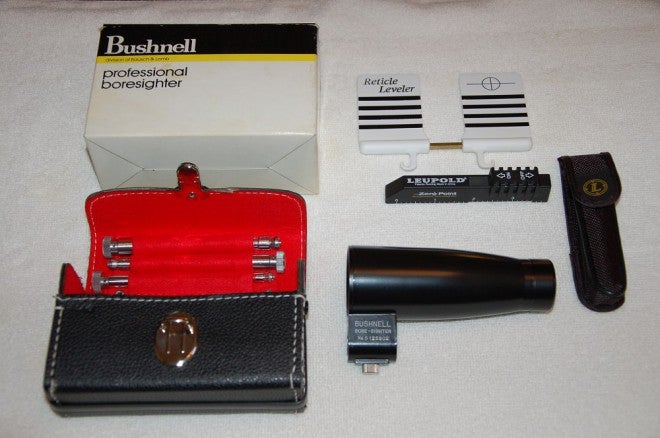Do Boresighters Really Work?
Dr. John Woods 02.16.16

You’ve seen them in the shooting stores or catalogs. There are several different kinds, including now models using a laser beam to project on the wall to align the scope crosshairs with the rifle’s bore. But do they really work and just how precise are these devices?
I’ve seen this happen many times and witnessed it again last week. I was in a mom and pop gun shop and watched the owner mount a new scope on a hunting rifle. Then he pulled out the boresighter and fiddled with getting the reticle on the scope to match the lines in the sighter. I would bet a hundred bucks the buyer of that scope never shot that rifle in at the range before going hunting. I wonder if he hit his target?
I have used a series of boresighter rigs many times over the past 40 or so years of mounting scopes and shooting rifles at the range. To me the whole process has really been a hit or miss proposition, no pun intended. Sometimes the boresighting is right on, other times I scratch my head wondering what happened.
Case in point was last weekend at the deer camp shooting range. I had a new Remington 700 Tactical rifle in .308 Winchester with a freshly mounted Leupold VX-2, 3x9x50mm, my all-time favorite scope. I performed the boresighting myself, or I thought I did.
I had two boxes of standard Remington Core-Lokt 150 grain hunting ammunition to sight the rifle in at 100 yards. I use the standard 3-inches high at 100. For the first set of three shots twice, there were no holes in the target. None! I was dismayed, as you can imagine.
So, I did what I should have done first and moved to 25 yards for a “print on the target” series. The holes immediately showed up in the lower quadrant of the paper target. Within six more rounds I was punching holes dead center on the target. So I backed up and started over.
By the end of the first box, I was hitting in the vicinity of where I wanted. Working into box No. 2, I got some respectable groups, three inches above the center, and into a 2-3 inch grouping. Not bad for old eyes using eyeglasses (which I hate with a passion). This rifle was ready to hunt.
But, what happened to the precision process of using the boresighter to “get on paper?” Honestly I have no clue. Had I gone hunting with the thought that the rifle was appropriately sighted in, I would have missed any deer I shot at. Also, being in a rush, I violated my own rule of an initial 25-yard sight in just to ensure that the bullets were hitting somewhere on the target. Shame on me.
The lessons learned here are simple ones. A boresighter might well help get the scope and bore initially lined up within the ballpark, but nothing in terms of a guarantee on that should be assumed. This is where target range shooting at a known distance is essential to fine tuning the rifle for more precision shooting. This is also the part that many buyers of new rifles and scopes fail to follow through on. Hope you’re not going grizzly hunting with that thing.
Also while I am at it, let me also point out a couple other critical aspects of mounting and preparing a new scope for its best performance. That dealer did not even have the shooter in the store to let him adjust the scope’s mounting eye relief. He just mounted the scope in the center of the rings. That may work some of the time, but it is not a best practice.
When the buyer came him, he bragged on how great the new scope looked on his rifle. He picked it up (once), looked through the lens, and pronounced it ready to kill a trophy. Oh, he also did nothing to focus the eyepiece to suit his own eyesight. I bet a good pair of wool socks it was not only blurry, but without a pre-set eye relief, there was also a dark ring around the inside of the scope view. Hmmmm. Truth is he might not have even known the difference.
So, when you mount a new scope, align for the proper eye relief to have a full, clear circle of light in the scope. Adjust the eyepiece to a clear focus, then lock it down with the lock ring. If the scope is a variable, double check this with all power ranges on the scope.
Buy a quality boresighter and align the crosshairs. But then take the rifle to a set range and print a few holes at 25 yards to see what is happening. Get it centered there, then back off to 100 yards to finish the process to the sight-in height you want for the ammo you use.
I have never used one of the new laser boresighters, so we would be every interested in AO readership on experiences using one of those. If they are as good as the press says, then I may have to break down and get one. Hey, Santa, did you hear that one?